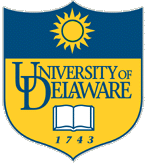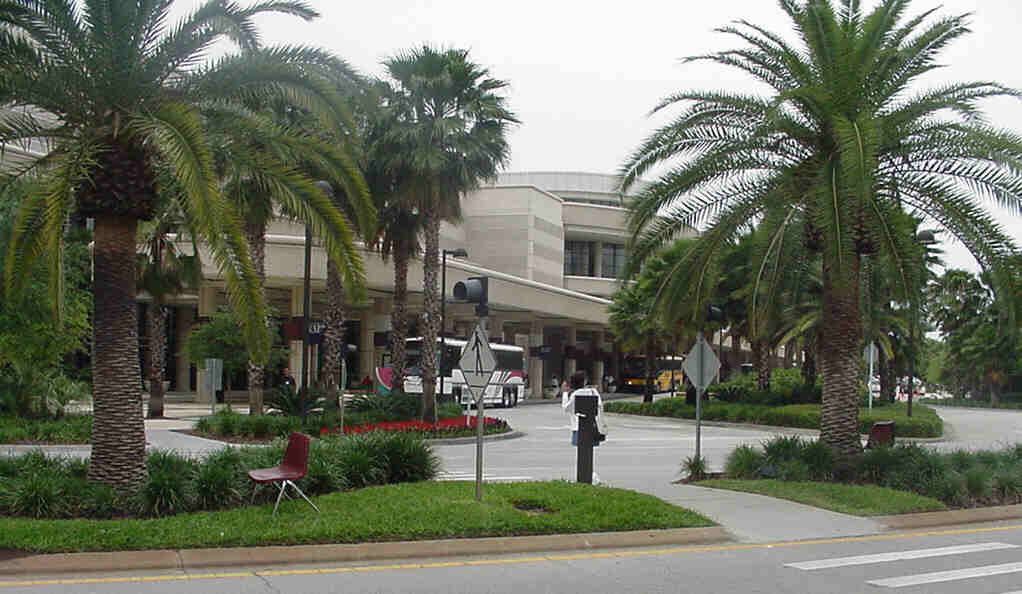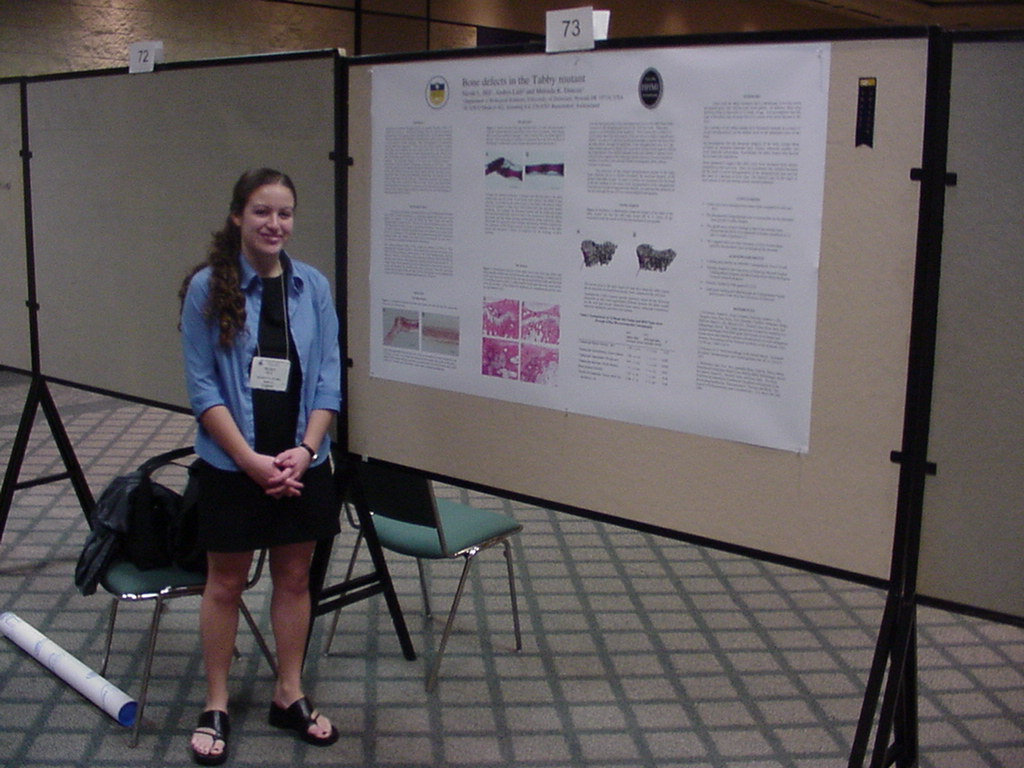 |
WIN RECOGNITION AT EXPERIMENTAL BIOLOGY MEETINGS IN ORLANDO |
 |
 |
WIN RECOGNITION AT EXPERIMENTAL BIOLOGY MEETINGS IN ORLANDO |
 |
 |
Welcome to the Orange County Convention Center, site of the 2001 Experimental Biology Meetings where six Unversity of Delaware students presented their research at the Undergraduate Research Poster Session sponsored by the American Society for Biochemistry and Molecular Biology, March 29 to April 4, 2001 |
The University of Delaware group included three faculty and six undergraduates.
| From left to right.
Prof. Gregory Stephens (Biological Sci.) Prof. David Usher (Biological Sci.) Jaimie Robinson(Jr. Biochem.) Jennifer Crocco(Jr. Biochem.) Michael Usher (Jr. Biotech.) Nicole Hill (Jr. Biotech.) Jennifer Rutan (Sr. Biotech/History) Melissa Kuchar(Jr. Med. Tech.) Prof. Hal White (Chem. and Biochem.) |
|
Three students received awards.
| Jennifer Crocco (right) received a First Place Award and Michael Usher (left) received an Honorable Mention in the ASBMB Undergraduate Poster Competition. Jennifer Rutan (center) received the Portland Press/Biochemical Journal Honorable Mention Award in the same poster competition. |
Thomas
Cech, President of HHMI
and 1989 Nobel
Laureate in Chemistry,
stopped
by to visit with the University of Delaware students and discuss
their
research projects.
|
|
| From left to right: Thomas Cech, President of HHMI, Melissa Kuchar, Jennifer Rutan, Jaimie Robinson, Jennifer Crocco, Michael Usher, and Nicole Hill. |
Students with their posters and Abstracts.
|
Adenylosuccinate Lyases Equivalent to Mutations Found in Human Adenylosuccinate Lyase Deficiency. |
Adenylosuccinate lyase (ASL) catalyzes 2 reactions in the de novo synthesis of purine nucleotides. In humans, point mutations of this enzyme are associated with mental retardation, autism, and muscle wasting. The sequence of B. subtilis ASL is 27% identical and 17% similar to the human enzyme. We have cloned, expressed, and purified B. subtilis ASL; the crystal structure of a 73% homologous bacterial enzyme is known (PDB #lc3u). We separately mutated 2 amino acids in the B. subtilis ASL (M10L & N276C) equivalent to the mutations identified in human ASL deficiency (M26L & R303C). The purified M10L and N276C possess specific activities of 0.86 and 0.38 units/mg, respectively, as compared to 1.56 units/mg for wild type (WT) enzyme. Both enzymes are similar to WT in conformation and oligomeric state as indicated by circular dichroism and light scattering. The Km for adenylosuccinate (SAMP) is not appreciably different between M1OL (5.6 uM) and WT (4.9 uM); and the pH dependence of Vmax is also similar. However, a marked difference between the 2 enzymes is observed in the thermal denaturation experiments: at 42.5 °C, M1OL enzyme rapidly loses activity with k = 0.08 min-1. WT enzyme is completely stable over 1 hour. The instability of the human equivalent of the M1OL enzyme may account for ASL deficiency in patients. In contrast., the N276C enzyme is as stable as WT enzyme at 42.5 °C. In N276C, the Km for SAMP is increased 2-fold at pH 7.0, and up to 4-5 fold at pH 8.0-8.5, compared to WT enzyme. The reduced activity of N276C may be attributed to changes in the pH dependence of KM for SAMP. Replacement of N276 may distort the adjacent E275, which is normally 2.7 A from H141 in the active site and influences the pK of this criticaI general acid/ general base as well as affecting substrate binding. Distortion of the E275-H141 interaction caused by change of the human equivalent of position 276 may be the basis of ASL deficiency in these patients. (Supported by NSF Grant MCB-97-28202). |
|
in Eristostatinís Inhibition of Metastasis Melissa Kuchar, Carrie Paquette, Mary Ann McLane |
Eristostatin, a disintegrin found in viper venom, can inhibit the metastasis of melanoma cells in a mouse model. To identify the amino acids that are critical for eristostatinís interaction with melanoma cells, we expressed bacterial recombinant eristostatin, echistatin (a structurally similar disintegrin), and six mutations targeting amino acids known to be important for these disintegrinsí biological activities. Human 1205 Lu, 164, and C8161 melanoma cells were incubated in an eight-chambered slide in the presence of fluorescently labeled eristostatin and 0, 500, or 1000 nM of an unlabeled disintegrin. Human MV3 melanoma cells were incubated with fluorescently labeled anti-?4 and 3000 nM unlabeled disintegrin. The cells were observed by confocal microscopy. For 1205 Lu, 164, and C8161 cells, the mutations in which RGD had been replaced with AGD or from which the six C-terminal residues had been removed did not inhibit labeled eristostatinís binding to the cells. This suggests that the RGD sequence and the C-terminus are critical for eristostatinís binding to these cells. Four proteins with methionine at position RGDXM inhibited labeled eristostatinís binding at a higher level than unlabeled eristostatin did. This suggests that asparagine is not a critical residue and that methionine enhances the ability of the disintegrin to interact with 1205 Lu, 164, and C8161 cells. Eristostatinís interaction with MV3 cells, similar to the other three cell lines, involves the RGD sequence and the C-terminus. Eristostatin did not inhibit when asparagine at position 31 or tryptophan at position 30 were replaced, suggesting that those two residues are critical for eristostatinís binding to MV3 cells. We hypothesize that eristostatin uses the same mechanism to interact with 1205 Lu, 164, and C8161 cells, and that this mechanism is different than the one used with MV3 cells. |
|
Nicole Hill, Andres Laib, Melinda Duncan Anhydrotic Ectodermal Dysplasia (EDA) is a genetic disorder, which is X-linked and recessive. Individuals affected with this disorder experience dysfunctional sweat glands, poorly developed teeth, and premature balding. The gene affected by this disorder is Ectodysplasin, a protein that is proposed to be involved in cellular signaling. Mice with mutations in Ectodysplasin develop the Tabby phenotype. These mice have defects similar to humans with EDA, and in addition, develop a kink in their tails. The phenotype of the Tabby tails was examined via a whole-mount stain involving Alizarin Red and Alician Blue, and the histology was examined by hemotoxylin and eosin staining. The structural integrity of the bone was examined through 3-dimensional microcomputed tomography, focussing on the tibia. Using statistical analysis, it was determined that the trabecular bone characteristics of the tibia differed between the Tabby mutant and the wild type mouse. Trabecular bone volume and trabecular connections were greater for the Tabby mutant than for the wild type. Trabecular separation was decreased for the Tabby when compared to the wild type. Since it has been recently determined that Ectodysplasin is expressed in the bone of developing mouse embryos, this evidence suggests a taking a closer look into the bone integrity of individuals affected with EDA |
 |
|
lead to 4-thiouridine in yeast tRNA? Jaimie S Robinson and Eugene G Mueller |
In E. coli, IscS
and Thil are the only proteins needed to convert the uridine at position
8 of tRNA into 4-thiouridine (s4U)í. If E. coli are subject
to near-UV light, a crosslink forms between the s4U at position
8 and the cytidine at position 13 on the same tRNA. This crosslink makes
tRNA a poor substrates for amino-acyl tRNA synthetases, therefore causing
arrested cell growth2. Eukaryotes lack s4U in tRNA and Thu homologs,
but eukaryotes do have IscS homologs. Since unfractionated yeast tRNA is
a susbstrate for E.coli enzymes in vitro, we reasoned that expression
of Thu in yeast should lead to s4U generation in S. cerevisiae,
which would prove a useful system for both revealing substrate specificity
and monitoring gene expression in yeast. A vector appropriate for expression
of Thu in yeast has been constructed and transformed into S. cerevisiae.
The content of s4U in isolated yeast tRNA will be monitored
before and after induction of Thu expression, and if s4U is
observed when Thu is expressed, the sensitivity of the yeast to near-UV
light will be examined. To confirm that Thil and the yeast IscS homolog,
Nfs1p, can function together, NSF1 has been cloned for overexpression
in E. coli, and the purified yeast protein will be assayed for ability
to support in vitro s4U production in conjugation with ThIL
The results of these experiments will be presented.
1. Kampabati R, Lauhon CT. 1999. IscS is a sulfurtransferase for the in vitro biosynthesis of 4-thiouridine in Escherichia coli tRNA. Biochemistry 38:16561-16568. 2. Favre, A. Bioinorganic Chemistry: Photochemistry and the Nucleic Acids. New York: John Wiley and Sons. 1990 |
|
Al-ClIl Linkage Group in Reptiles. Jennifer Rutan, Michael Usher, Matthew Russell, Robin Davis, Shui QingYe, Greg Stephens, Robert Hodson and David C. Usher |
Apolipoprotein C-Ill (apoC-Ill), a protein which influences the catabolism of triglyceride-rich lipoproteins, has previously been observed only in mammals. A cDNA sequence was isolated from a turtle, Pseudymes scripta, liver expression library, and shown to be the equivalent to mammalian apoC-III. Comparison of the turtle and human sequences indicated 39% amino acid identity but 61% similarity. In particular, sequences for the second and third of the six 11 amino acid (11-mer) repeats were highly conserved. Like mammalian apoC-III, turtle apoC-Ill with a predicted MW of 10,504, is found associated with both HDL and triglyceride-rich lipoproteins and is synthesized mainly by the liver. Using PCR primers based on the cDNA sequence, the sequence of the turtle apoC-Ill gene was determined. Like mammalian apoC-III, the turtle gene contains four exons and three introns. The exon length and exon/intron boundries are also similar to those found for humans although the introns are more variable. The results suggest that exon 3 which encodes the first, second and third 11-mer repeats has been more highly conserved relative to the fourth exon which encodes the rest of the protein. The conservation of the cDNA sequence, gene structure and lipoprotein associations suggests turtle apoC-III plays a role similar to that described in mammals. Genome walking was then used to establish that the turtle apoC-Ill and apoA-I genes were linked. As in mammals, the orientation of the two genes is opposing, with the promoters for the two genes being distal and the 3í ends being proximal to each other. Since the evolution of turtles is separated by an estimated 300 millions years from humans, the conservation of the linkage group supports the conclusion that the two genes play a coordinate role in lipoprotein metabolism. |
|
to dsDNA for Site-Specific Gene Repair Michael Usher, Howard Gamper, Eric Kmiec
|
Chimeric oligonucleotides consisting of both RNA and DNA configured as a double-hairpin have been shown to cause site-directed mutations involving the processes of homologous recombination and gene conversion. In order to increase the efficiency of gene repair, we have been studying the mechanism of recombination with both prokaryotic and eukaryotic recombinases. To measure the relative efficiencies of gene targeting we have adapted an in vitro system, involving the incubation of various model RNA/DNA hybrid hairpins and recombinases, followed by the addition of a radio-labeled target. After stripping away the recombinase, the resulting chimera/target joints were analyzed by PAGE. Recombination, mediated by eukaryotic Rad5 1 protein, produced a low yield of Y-arm product formation with short linear dsDNA targets. Although the efficiency of the product formation is considerably less than that observed for the same system using RecA, we suspect using accessory proteins such as Rad54 will dramatically increase targeting efficiency. To our knowledge this is the first demonstration of reciprocal four-strand exchange catalyzed by the Rad5 1 protein. On the other hand RecA mediated recombination produced high levels of double D-loop product with both short linear dsDNA and supercoiled plasmid targets. The formation of double D-Ioops under these conditions approached 90%, far more efficient than what has been reported previously. Earlier research suggested the formation of a double D-loop intermediate during gene targeting; these results give ftirther evidence to support this conclusion, as well as a method of efficiently producing these structures for further mechanistic studies. |
Return to University of Delaware HHMI Home Page
Created 10 April 2001, Updated 24 May 2001 by Hal White
Copyright 2001, Harold B. White, Department of Chemistry and Biochemistry, University of Delaware